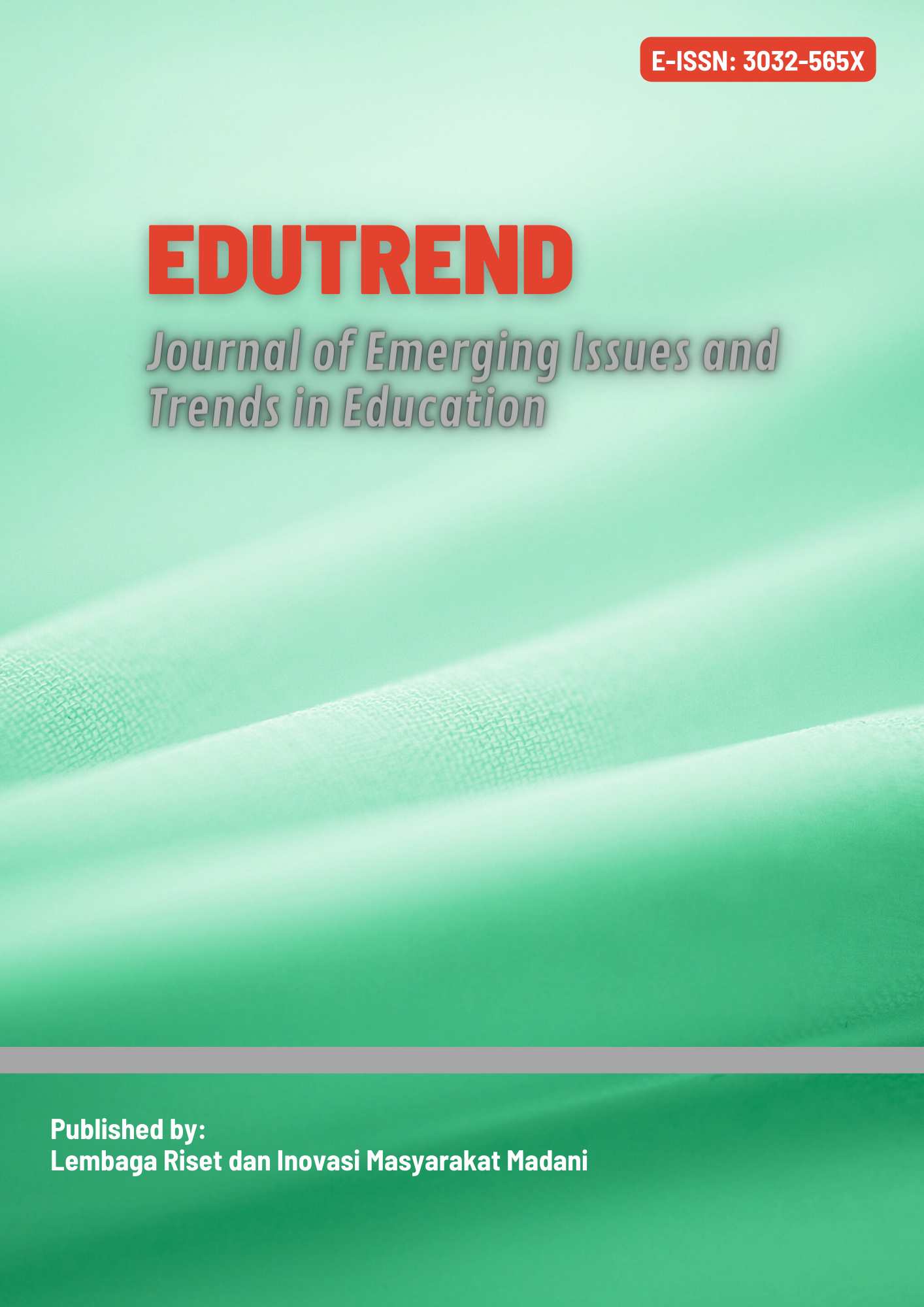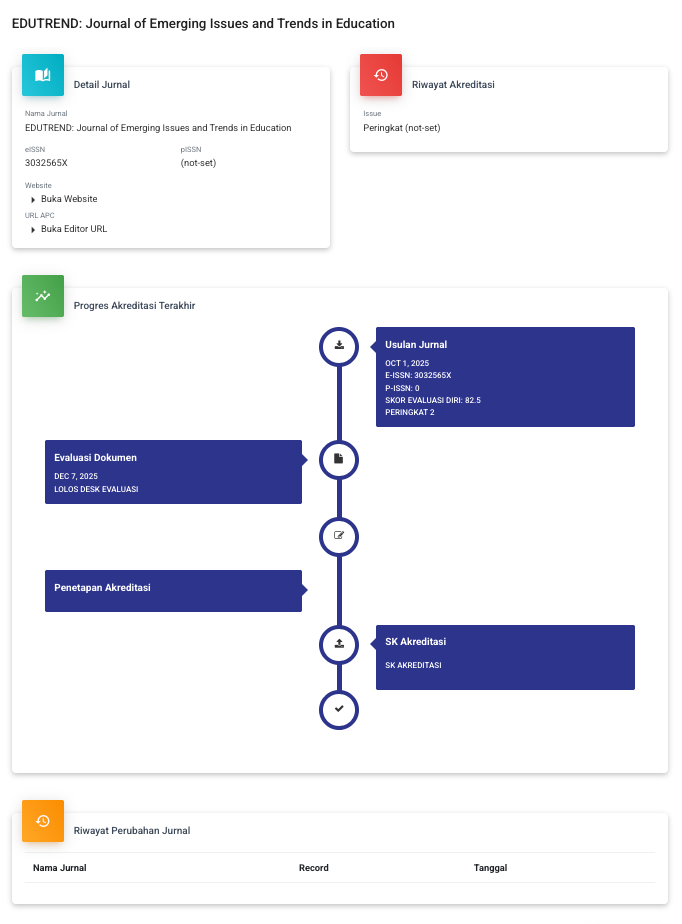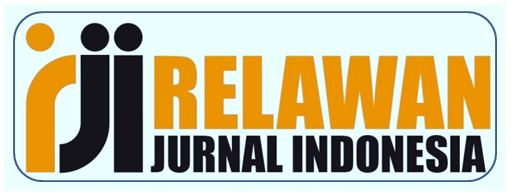Online Teaching Preparedness Among Nepali EFL Educators: Determinants unveiled
DOI:
https://doi.org/10.59110/edutrend.622Keywords:
Digital Pedagogy, ICT Integration in EFL, Online Teaching, Technology in Education, Virtual LearningAbstract
This study examined the preparedness of Nepali teachers of English as a Foreign Language to teach online. It considered various factors, including demographic (gender, age, and education) and professional contexts (school location—rural vs. urban, teaching level—basic vs. secondary, employment status—permanent, temporary, relief grant quota, institutional, or school type—institutional vs. community), along with their ability to reconfigure content prepared for conventional teaching to online teaching. An online survey of 236 EFL school teachers was analyzed using SPSS 20.0, with findings presented through tables, a heat map, and bar diagrams. Results indicated that the preparedness determinants include ICT skill training, school type (institutional vs. community), school location (urban vs. rural), job nature, and academic qualification. The findings also showed training and institutional context as driving forces behind EFL teachers’ digital preparedness.
References
Akdemir, Ö. A. (2019). Student teachers’ preparedness to teach: The case of Turkey. International Education Studies, 12(3), 90–96. https://doi.org/10.5539/ies.v12n3p90
Al-Awidi, H., & Aldhafeeri, F. (2017). Teachers’ readiness to implement digital curriculum in Kuwaiti schools. Journal of Information Technology Education: Research, 16, 105–126. https://www.informingscience.org/Publications/3685
Awasthi, J. R. (2010). Teacher education with special reference to English language teaching in Nepal. Journal of NELTA, 8(1–2), 17–28. https://doi.org/10.3126/nelta.v8i1.3377
Callegaro, M., Manfreda, K. L., & Vehovar, V. (2015). Web survey methodology. Sage Publications Ltd.
Cui, C. C., & Greatorex, M. (2014). Bivariate analysis. In C. L. (Ed.), Wiley encyclopedia of management. John Wiley & Sons, Ltd. https://doi.org/10.1002/9781118785317.weom090351
Damarin, S. K. (2002). 'Digital divide' versus digital differences: Principles for equitable use of technology in education. Educational Technology, 40(4), 17–22. http://www.jstor.org/stable/44428620
Damien, N., & Claire, M. M. (2022). Influence of teachers’ preparedness on students’ academic performance in public secondary schools in Rwanda. Journal of Education, 5(2), 53–71. https://doi.org/10.53819/81018102t5069
Elzer, S., Carberry, S., & Zukerman, I. (2010). The automated understanding of simple bar charts. Artificial Intelligence, 175, 526–555. https://doi.org/10.1016/j.artint.2010.10.003
Enu, J., Nkum, D., Ninsin, E., Diabor, C. A., & Korsah, D. P. (2018). Teachers’ ICT skills and ICT usage in the classroom: The case of basic school teachers in Ghana. Journal of Education and Practice, 9(20), 35–38. https://www.iiste.org/Journals/index.php/JEP/article/download/43378/44693
Evans, J. R., & Mathur, A. (2005). The value of online surveys. Internet Research, 15(2), 195–219. https://doi.org/10.1007/s11135-005-8081-8
Ghavifekr, S., & Rosdy, W. A. W. (2015). Teaching and learning with technology: Effectiveness of ICT integration in schools. International Journal of Research in Education and Science (IJRES), 1(2), 175–191. https://files.eric.ed.gov/fulltext/EJ1105224.pdf
Hagger, H., & McIntyre, D. (2006). Learning teaching from teachers: Realising the potential of school-based teacher education. Open University Press.
Hasyim, N., Arismunandar, N., Butarbutar, R., Ramli, A. M., & Nur, I. D. M. (2024). Mind mapping of teachers’ readiness for online teaching and learning: A reflective study of urban and suburban areas. Cogent Education, 11(1). https://doi.org/10.1080/2331186x.2023.2292864
Holmes, S. R. (2011). Teacher preparedness for teaching and assessing depth of knowledge (Publication No. 448) [Doctoral dissertation, The University of Southern Mississippi]. Aquila. https://aquila.usm.edu/dissertations/448
Hooker, C. M., & deZúñiga, H. G. (2017). Survey methods, online. In J. Matthes (Ed.), The international encyclopedia of communication research methods (pp. 1–7). John Wiley & Sons, Inc. https://doi.org/10.1002/9781118901731.iecrm0244
Jung, Y. M. (2019). Data analysis in quantitative research. In P. L. (Ed.), Handbook of research methods in health social sciences (pp. 955–969). Springer.
Kiamba, E. W., & Mutua, F. (2017). A critical review of the effect of teacher preparedness on students’ academic achievement: A research agenda. Scholarly Research Journal for Interdisciplinary Studies, 4(37), 8790–8798. http://oaji.net/articles/2017/1174-1522064089.pdf
Kumar, I., Yadav, N., & Verma, A. (2025). Navigating artificial intelligence in scientific manuscript writing: Tips and traps. Indian Journal of Radiology and Imaging, 35(S1), S178–S186. https://doi.org/10.1055/s-0044-1800801
Luhamya, A., Bakkabulindi, F. E., & Muyinda, P. B. (2017). Integration of ICT in teaching and learning: A review of theories. Makerere Journal of Higher Education, 9(1), 21–36. https://doi.org/10.4314/majohe.v9i1.2
Madariaga, L., Nussbaum, M., Burq, I., Marañón, F., Salazar, D., Maldonado, L., & Naranjo, M. A. (2017). Online survey: A national study with school principals. Computers in Human Behavior, 74, 35–44. https://doi.org/10.1016/j.chb.2017.03.067
Mayo, C. L., & Bradley, F. (2023). The impact of teacher preparedness and professional development on Fourth-Grade students’ science achievement. Journal of Research Initiatives, 8(2), 5. https://digitalcommons.uncfsu.edu/jri/vol8/iss2/5
Nepal, B., & Atreya, A. (2020). Online medical education in Nepal: Barking a wrong tree. Journal of Lumbini Medical College, 8(1), 141–143. https://doi.org/10.22502/jlmc.v8i1.325
Sammut, R., Griscti, O., & Norman, I. J. (2021). Strategies to improve response rates to web surveys: A literature review. International Journal of Nursing Studies, 123, Article 104058. https://doi.org/10.1016/j.ijnurstu.2021.104058
Shah, R. K., Paneru, N. R., & Bohara, B. B. (2024). Digital inclusion struggles: Virtual learning experiences of English education students at Tribhuvan University, Nepal. Philip Roth Studies, 20(2). https://doi.org/10.5281/zenodo.15074503
Sosulski, K. (2018). Data visualization made simple: Insights into becoming visual. Routledge.
Sue, V. M., & Ritter, L. A. (2007). Conducting online surveys. Sage Publications.
Thapaliya, M., Adhikari, S., & Rana, L. (2023). Opportunity in COVID-19 crisis: Moving away from chalk and talk to technology-integrated teaching in Nepalese higher education institutions. E-Learning and Digital Media, 21(1), 87–105. https://doi.org/10.1177/20427530231153944
Tsai, C.-W. (2012). The role of teacher's initiation in online pedagogy. Education and Training, 54(6), 456–471. https://doi.org/10.1108/00400911211254253
UNESCO. (2020, August 18). COVID-19 impact on education. https://en.unesco.org/covid19/educationresponse
Upadhyay, H. P., Koirala, P., & Sedain, P. (2021). University students’ attitude towards virtual learning during COVID-19 pandemic in Nepal. Journal of Chitwan Medical College, 11(3), 11–15. https://doi.org/10.54530/jcmc.496
Watson, D. M. (2001). Pedagogy before technology: Re-thinking the relationship between ICT and teaching. Education and Information Technologies, 6(4), 251–266. https://doi.org/10.1023/A:1012976702296
World Bank. (2020, April 7). The Government of Nepal and the World Bank sign $29 million financing agreement for Nepal’s COVID-19 (Coronavirus) response [Press release]. https://www.worldbank.org/en/news/press-release/2020/04/03/world-bank-fast-tracks-29-million-for-nepal-covid-19-coronavirus-response
Yadav, S. (2023). Digital skills of teachers: A necessity for the technology-enabled human resource of the education sector in the fast transformation. In E. Podovšovnik, T. D. Giuseppe, & F. Corona (Eds.), Handbook of research on establishing digital competencies in the pursuit of online learning (pp. 187–207). IGI Global. https://doi.org/10.4018/978-1-6684-7010-7.ch010
Collado, Z., Pantaleta, F., Landagan, M., Rescober, A., Baral, G., Villareal, M., Banaria, D., & Cortez, C. (2024). Switching to virtual classes: exploring teacher readiness under the ‘new normal’. Technology, Pedagogy and Education, 33, 187 - 199. https://doi.org/10.1080/1475939X.2024.2305341.
Rashid, A., Shukor, N., Tasir, Z., & Na, K. (2021). Teachers’ perceptions and readiness toward the implementation of virtual learning environment. International Journal of Evaluation and Research in Education (IJERE). https://doi.org/10.11591/IJERE.V10I1.21014.
Downloads
Published
How to Cite
Issue
Section
License
Copyright (c) 2025 Bhuban Bahadur Bohara

This work is licensed under a Creative Commons Attribution-ShareAlike 4.0 International License.















 the Creative Commons Attribution-ShareAlike 4.0 International License |
the Creative Commons Attribution-ShareAlike 4.0 International License | 